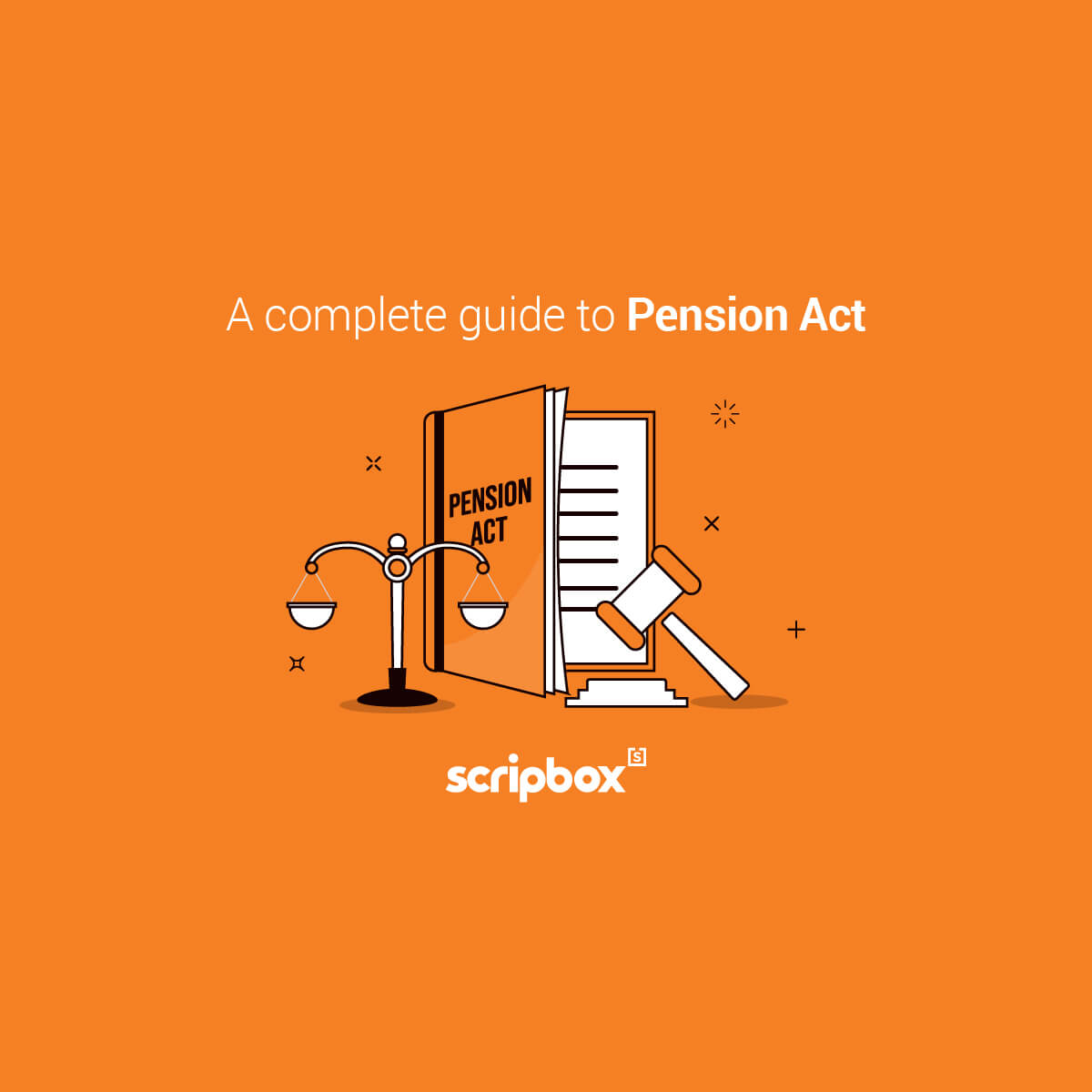Life comes with no guarantee. We live in a completely unpredictable world where we have no clue about the future. With increasing life expectancy it becomes of utmost importance to plan your retirement now and secure your future.
Retirement means to ”withdraw from one’s position or occupation or from active working life.” No work leads to no income source. Therefore, one must plan their future accordingly so as to enable them to lead a happy retirement life without worrying about the income source.
Planning retirement is to gain financial independence which can be achieved if you invest in a proper Pension Plan. Pension Plans help one secure their future thereby lead a hassle free retirement life.
What is a Pension Plan?
Pension Plan or Retirement Plan is a kind of fund to which a specific amount of money from your pay is invested during the tenure of your employment. This investment further helps in drawing payments during the retirement period. A Pension Plan can also be defined as a benefit plan. As the name suggests the investments now lead to benefit in the future and is ideal for financially securing senior citizens.
A fixed investment now into a Pension Plan makes the future financially secured. These investments help one achieve financial securities and overcome any other uncertainties that may evolve in the future.
With the increasing cost of living and rising inflation, it has become all the more important to invest in a good Pension Plan. This will not only lead to future financial security but also help one lead a happy life without compromising the living standards.
Pension Plans sometimes also come with insurance cover. These plans are usually Long Term Plans. Investments in these Plans can be made either monthly or quarterly. All you have to do is pay an amount regularly over a fixed period of time and enjoy the benefits after you retire.
Why do you need to start Retirement Planning?
Old age is a factor that governs both the physical and mental health of an individual. It is a phase where you surpass the life expectancy of human beings. This is the best time to sit back and enjoy life.
But for leading a comfortable and relaxed life one needs to start planning for their retirement and start planning now. Yes, life moves on and soon you would be attaining an age of retirement. An age where your physical state would not allow you to work. It’s the time you would want to spend with your family and close ones for which planning is all that it takes.
Sooner or later you will be grappling with daily expenses, medical bills, and other expenses. Savings may get exhausted in an unwelcome emergency. However, a well-planned Retirement now can lead you to a better life later.
Planning Retirement becomes very important. The basic motive of Retirement Planning is to ensure that your basic needs are fulfilled even when the income source ceases. How early you plan your retirement will determine the kind of life you would live post retirement.
Let us look into the top four reasons why you should start planning your retirement
Old Age
This is one of the important reasons why one should start retirement planning. At this age, it becomes physically and mentally impossible for an individual to work and earn a living. This is an age where everyone wishes to relax and enjoy the rest of the days with peace. A well-planned retirement can help you retire with ease.
Medical Emergencies
Old age leads to many health issues. Medical expenses can have a negative effect on your saving plan post retirement. A proper Retirement Plan can save you from such difficulties that may arise in the future.
Inflation
Due to the current high standard of living and rising inflation, it has become all the more important to start Retirement Planning. The earlier you start, the secure your future becomes.
Nuclear family
The joint family system was a past affair where the household expenses were distributed among the members of the family. Now people move out of the joint family due to many reasons. In a nuclear family, the sole responsibility of the daily expenses lies in one single person. Hence, during the retirement time, all the expenses are borne by him. This is one reason why you should plan your retirement. `
Hence, pre-planned retirement and investment made in a proper Pension Plan can save you from any abnormalities that may arise post retirement. Therefore, you should set a financial goal and plan your retirement accordingly.
Types of Pension Plans in India
Investing in a good Pension Plan as per your financial goal is the first criteria one must follow. There are several Pension Plans available in India which gives you varied benefits. Choosing the right plan is the first step towards a secure future.
There are a wide variety of Plans available in the market. Each plan has a specific classification with regard to its structure and benefits. All Pension Plans have a divergent benefit structure. Let us know the different types of Pension Plan available in India-
1. Deferred Annuity Pension Plan
Annuities have been popular as they offer guaranteed income. People are looking for smarter ways to invest and manage their retirement savings. These are a kind of insurance plan for long term savings.
A Deferred Annuity option requires an investor to build a corpus that can later be used to buy an annuity at the time of retirement. The Life Insurance Company promises to pay the insurer a regular or lump-sum amount at the future maturity date. These Annuities can be purchased by a one-time payment method or through a regular premium payment method. These also have the benefit of tax exemption up to a limit like any other insurance plan.
There are several different types of Deferred Annuity-
Fixed, Indexed, and Variable which further determines the computed rate of return. As the name suggests, Fixed Annuity promises a guaranteed or fixed rate of return, Index Annuity the return is based on the market index, and Variable Annuity is based solely on the portfolio of the Mutual Fund performance or other accounts so chosen by the owner.
Deferred Annuities are fixed or locked and are subject to charges at the time of early withdrawal. There are also tax penalties of 10% levied on any withdrawal made before the maturity date.
2. Immediate Annuity Pension Plan
Immediate Annuity is also a kind of life insurance premium pension plan that promises to pay a series of annuity payments throughout your life. You also have an option of a joint-life pension annuity plan under which annuity payments are made even during the lifetime of your spouse.
The purchase price of the annuity is payable in a single premium. The annuity payment frequency can be monthly, half-yearly, quarterly, or annually as per the choice of the Annuitant. These annuities offer guaranteed income almost immediately and the premium paid is tax-exempted as per the Income Tax Act 1961.
3. Certain Annuity Pension Plan
A Certain Annuity is offered by an Insurance Company limited. These are an investment in retirement income. A Certain Annuity option provides a guaranteed retirement income for a pre-specified period to the Annuitant or his nominees. The annuity can also be taken as a Lump sum.
Due to its set expiration date, these annuities provide higher returns than any other annuity option. These have high upfront fees and other charges as compared to other traditional annuities.
4. With Cover and Without Cover Pension Plans
Pension Plans with cover means the life of the Policy Holder is covered and upon his death, a lump sum amount is paid to his immediate family members also known as the nominees. These plans are like the typical insurance plan but the amount paid under these plans is not considerable. The large amount invested in these plans goes to the building of the corpus rather than covering the life risk.
Pension Plans without Cover are those plans where the life of the Policy Holder is not covered. Upon the death of the Policy Holder, the nominee only gets the corpus so built during his lifetime. Only Long Term insurance plans have the option of life cover like Deferred Annuity Scheme, unlike Immediate Annuity which is short term and does not cover life.
5. Guaranteed Period Annuity
As the name suggests a Guaranteed Period Annuity is an annuity that offers guaranteed return. This annuity ensures that the immediate family members of the Annuitant are benefitted even after the death of the Policy Holder throughout the entire period of guarantee of the annuity.
6. Life Annuity Pension Plan
Life Annuity is the most common type of Pension Plan. Under this plan, a Policy Holder or Annuitant is guaranteed a life pension annuity income throughout his life. It also provides the option of Joint-Annuity where the annuity is paid to the spouse even after the death of the Policy Holder.
7. Life ULIP Plan
Life ULIP Plan or Unit Linked Investment Plan is a single integrated plan where unlike a traditional insurance plan both life cover and investment are provided. These are offered by Insurance Companies.
A portion of the investment made under these plans is utilized to provide life cover and the remaining is invested in Equity and Debt Funds. There are certain charges levied on these schemes, unlike the traditional Insurance Policies.
The returns under the Unit Linked Insurance Plan depends entirely on the market conditions and the risk of investment is solely borne by the PolicyHolder.
8. Defined Benefit Pension Plan
A Defined Benefit Pension Plan is one where a specified pension payment, lump-sum, or combination thereof is paid to the employee by his employer. These are employer-sponsored retirement plans. The benefit of an employee is computed taking into account his age, earnings, tenure of service, etc.
The incomes under this plan are generated solely on the basis of your work. It is a joint contribution of both you and your employer that makes retirement much easier.
9. Defined Contribution Pension Plan
Defined Contribution Pension Plan requires one to contribute their own money towards a retirement plan. Here both the employer and the employee make contributions on a regular basis.
Accounts are set up for each individual and benefits are calculated as per the credits held in these accounts through both employee and employer contribution. A predetermined portion of the employee’s income goes towards these accounts as his contribution and the rest is matched by the employer. This contribution can later be used as retirement benefits by an employee.
10. National Pension Scheme (NPS)
One of the most significant steps taken by the Government of India was the introduction of the National Pension Scheme (NPS). Though the Scheme was initially applicable to Government Employees only later the same was opened for all the citizens of India in 2009.
This Scheme was introduced to safeguard the retirement benefits of the individual post retirement. Due to its tax savings benefit, NPS has become a popular investment scheme in recent times. These are managed by the Pension Fund Regulatory And Development Authority.
Under this Scheme, only 60% of the fund is withdrawable on retirement. The rest of the 40% fund is further utilized in purchasing annuities.
11. Pension Funds
Pension Funds are another type of Retirement Pension Plan which are popular among the investors. These Funds usually have a large amount of money invested and the returns are higher as compared to the other retirement plans.
Comparison Between Pension Plans
Choosing the right plan as per the needs and financial goals can be a difficult but critical decision. The right decision made now benefits one in the future. Likewise, a smart decision made now will lead to a better life post retirement. Hence, it becomes very important to select the best plan so as to secure your financial needs during old age.
A comparison between the different Pension Plans will give a better understanding of these plans and further assist in making the right choice.
| Retirement Plans | Tax on Income | Applicable Tax on Investment | Tax on withdrawal | Withdrawal Flexibility | The flexibility of Increase and Decrease Income | Lock-in Periods |
| Deferred Annuity | Taxable | Tax-free | 1/3rd non-taxable 2/3rd taxable | After expiry of 1 year 10% of the annuity value can be withdrawn without surrender charge | No | Up to 10 years |
| Immediate Annuity | Applicable Income Tax rate | Exempted | 2/3rd taxable 1/3rd non-taxable | Post expiry of 1 year 10% of the annuity value can be withdrawn without surrender charge | No | Up to 15 years |
| Certain Annuity | Under the Income Tax rate | Non-taxable | Taxed as Capital Gains | 33% of fund value upon retirement | No | 5 years, 10 years and 15 years |
| With and Without Cover Pension Plans | Taxed | No Tax | 1/3rd non-taxable 2/3rd taxable | Withdrawal up to 33% upon retirement | No | 5 years |
| Guaranteed Period Annuity | Taxable | Tax-Free | 1/3rd non-taxable 2/3rd taxable | Up to 33% of fund value upon retirement | No | Stops on the death of the annuitant |
| Life Annuity | Taxed | Exempt | 1/3rd non-taxable 2/3rd taxable | Withdrawal up to 33% of fund value upon retirement | No | 15 years |
| Life ULIP Plan | Exempted from Tax | Under section 80 up to 1.5 lakhs | Yes. 100% withdrawal tax-free | Yes. 100% withdrawal anytime after 5 years | Yes | 5 years |
| Defined Contribution Pension Plan | Taxed | Tax-Free | No.Withdrawal up to 33% on retirement | Withdrawal to up to 33% of Fund value on retirement | No | Depends on type of pension fund |
| National Pension Scheme (NPS) | Yes | Tax deductions under section 80 CCD(1B) upto 50K and section 80 upto 1.5 lakh | Upto 60% of the fund value tax free upon retirement | No. Partial withdrawal upto 25% after 10 years | No | Can be withdrawn at the age of 60 |
| Pension Fund | Taxed | Yes | No. Partial withdrawal upto 50% | Partial withdrawal upto 50% | No | Depends upon type of pension fund |
Eligibility Criteria for Retirement Plans
There are certain set eligibility criteria for a Retirement or Pension Plan. Let us discuss the most prominent eligibility criteria for Retirements Plans followed in India
Minimum and Maximum Entry Age
Like any other investment plan, there is an age criterion to be followed at the time of purchasing the Plan. Any individual who has attained the age of 18 years is eligible to purchase a Retirement Plan. While some companies have also set their minimum entry age at 30 years. Likewise, there is also a maximum age limit to purchase a Pension Plan. Most of the companies have set the maximum age at 75 years.
Vesting age
This is an age when the individual begins to receive the monthly pension. Most Pension Plans keep the minimum vesting age at 45 years while the maximum vesting age goes up to 80 years.
Premium
To purchase a Pension Plan one has to pay a minimum premium amount. The premium may vary from policy to policy and also the tenure. The premium has to be paid either monthly, quarterly, yearly or even a lump-sum amount can be paid for the chosen policy term.
Policy Term
Usually, the policy term depends on the Pension Plan chosen. The term ranges from 10 years to 30 years.
To secure the future one has to tactfully choose the right plan according to the investing capacity and financial goal one sets. Most importantly one has to plan their retirement as early as possible. This will enable one to allocate their saving plan in proper channels which will further build a corpus.
A suitable Retirement Plan will help one overcome inflation and also help in fulfilling the post retirement basic needs without being too harsh on the savings. This will assist in a fixed source of income post retirement when the actual income ceases.
Everyone wants to live a happy and relaxed retirement life. For this one can purchase a Pension Plan suitable for their needs and financial goals. Different Plans have different reaping benefits.
Top 15 Pension Plans in India 2025
| Pension Plans | Minimum Entry Age | Maximum Entry Age |
| LIC New Jeevan Shanti Plan | 30 Years | 79 Years |
| HDFC Life Click 2 Retire | 18 Years | 65 Years |
| SBI Life Saral Retirement Saver | 18 Years | 65 Years |
| ICICI Pru Easy Retirement | 18 Years | 70 Years |
| Max Life Guranteed Lifetime Income Plan | 45 Years | 80 Years |
| Bajaj Allianz Longlife Goal | 18 Years | 65 Years |
| Kotak Premier Pension Plan | 30 Years | 60 Years |
| Aditya Birla Empower Pension Plan | 25 Years | 70 Years |
| Tata AIA Guaranteed Monthly Income Plan | 6 Years | 60 Years |
| IndiaFirst Life Guaranteed Annuity Plan | 40 Years | 80 Years |
| Aegon Life Guranteed Income Advantage Plan | 20 Years | 55 Years |
| Aviva Next Innings Pension Plan | 42 Years | 60 Years |
| Canara HSBC Invest 4G Whole Life Plan | 18 Years | 55 Years |
| PNB Metlife Monthly Income Plan | 18 Years | 65 Years |
| Shriram Immediate Annuity Plan | 40 Years | 75 Years |
There are many such options available for the Pension Plan. You can choose a plan as per your needs for a secure future. These Pension Plans help you achieve your financial independence so you can enjoy your golden days.
How to Invest in a Best Retirement Plan Through Scripbox?
At Scripbox we understand that every individual has different post retirement goals. With the introduction of so many Pension Plan Schemes, it becomes extremely confusing to choose the right plan keeping in mind the financial goal and post retirement benefits.
We at Scripbox help you put your practical action plan in place to achieve financial freedom. Here we help you to estimate the right amount needed for your future financial security taking the inflation factor into consideration.
We also have personalized retirement planning as per your goals. Use our advanced tools to create a personalized financial plan and investment to be made. You can also keep track of your investments to know your actual gain.
All you have to do is tell us a little about your retirement goal like your current age, age of retirement, current monthly expense, and the age you are planning retirement benefit.
How to Select the Best Retirement Plan in India?
Financially securing old age has become one of the major concerns among individuals. The very thought of not having saved anything for the future is alarming. Moreover, inflation and the economy hit the common man to the worst. Hence, a proper retirement plan saves one from this distress in the future.
Before choosing a Pension Plan one has to keep in mind the financial goal and retirement age.
The following are the criteria one must follow before selecting a Retirement Plan:
Life Expectancy
This is one of the foremost criteria to be taken into consideration before selecting a Retirement Plan. The higher the life expectancy the higher the retirement financial goal of an individual. There is no fixed lifespan and the same varies from individual to individual.
The life expectancy as recorded in 2017 in India was 68.78 as per the World Bank which has subsequently increased over the years. Hence, your retirement fund should be sufficient enough for you to live a happy retirement life
Medical Emergencies
Old age comes with old age critical illnesses. One should be aware of this fact and choose a plan accordingly so that these expenses are covered well into the plan.
Monthly Expenses
During retirement, though the regular source of income ceases the monthly expense continues. Hence, one should build a corpus big enough to cover the monthly expenses and other unwelcome emergencies that may arise in the future.
Inflation
Inflation has a negative effect on our purchasing power. With rising inflation, the prices of goods have also increased. Thus, having the right Pension Plan will ease some tension and provide financial security.
Tax Benefits
Pension Plan also has tax savings benefits. This will give you tax benefits under section 80C of the provisions made by the Income Tax Act.
Estimate Your Financial Needs
It is difficult to estimate how much you would need to sustain during old age. But a rough estimation can go a long way.
- Research: A thorough research keeping in mind your financial goals will yield wholesome profit. Read about the different plans available and the retirement benefit it provides.
- Understand the Different Products: It is very important to choose the right plan from a wide variety of plans available in the market. Before choosing a plan one must shortlist plans which fulfil their financial expectation.
There are many Pension Plans available in India. One has to choose a plan as you desire depending on the financial needs for a secured future. These plans not only help in financial independence but also helps in tax exemption. Choose the right plan now and enjoy your golden period with dignity.
Features of pension plans in India
Pension Plans play a very significant role in deciding the kind of retirement one would live. Therefore, it becomes very important to know as much about these plans as possible.
Here we will discuss the prominent features of the Pension Plan available in India.
Guaranteed Monthly Income
Most of the Pension Plan offers a fixed income upon your retirement. Plans like Immediate Annuity allows you to receive monthly or annual income as soon as you invest. The pension can be paid either for a fixed period of time or until death. The same depends solely on the type of plan you choose.
Tax Benefits
The most important feature of a Pension plan is its tax savings nature. Many such plans give a tax exemption of 10% to 40% under section 80C of the Income Act. Tax exemption depends on the plan you choose. It is always advisable to start planning your retirement early so as to reap maximum tax benefits.
Vesting Age
Vesting age is where you start receiving a monthly Pension. The minimum vesting age in most plans is 40 to 50 years and the maximum vesting age is up to 75 years. Between the vesting age, one can decide at which age you would want to start receiving a pension.
Surrender Value
Every Plan has a maturity date. It is very important to wait for the plan you have purchased to complete its maturity date so you get the maximum benefit out of it. There are times when you still want to surrender due to some unforeseen emergencies, the same can be done and you would still receive the surrender value of the same provided the plan has crossed the minimum duration.
This feature is only available in Pension plans that include life insurance plan benefits.
Death Benefit
Many Pension Plans come with death benefits. This means after your death the nominee of your policy receives the benefit. There are Plans which offer both retirement benefits and life insurance cover. These plans usually offer higher death benefits than any other traditional Pension Plans.
The above-mentioned features will help you to choose a retirement plan as per your retirement goal and investment capacity.
Benefits of Retirement Plans in India
Retirement Plans or Pension Plans have gained a lot of popularity of late. People are now more keen on investing in a plan which offers both investment benefits and life covers. These plans provide varied benefits upon retirement. Hence, it is very important to know about the plans and its retirement benefits before purchasing a plan in India.
The following are some of the benefits of the Retirement Plan in India –
Long Term Investment
These schemes usually provide a long term plan. Because of the very nature of these schemes, the investment reaps high benefits. The funds are kept for a longer period of time so that a high corpus is built. This further ensures a steady flow of income post retirement.
Regular Income Post Retirement
Even though your monthly salary ceases to exist, your retirement income remains intact through these Pension Plans.. Pension Plans or Retirement Plans offer guaranteed income post retirement that helps you in meeting your day to day requirements.
Multiple Option of Payment
Many such plans come with multiple options for making the payment. You can either pay monthly, quarterly, annually or make a lump- sum payment. This makes it very easy for an individual to choose a payment method as per his convenience and earning. Irrespective of the mode of payment, the retirement benefit is sure to follow.
Insurance Cover
Some Pension Plans also come with Life Insurance Cover. These plans ensure that a lump sum amount is paid to the nominee of the Policyholder on his death. These plans offer the benefit of both investment and life cover at the same time.
Tax Benefit
Contributions made under the Retirement Plans are tax-exempt up to a maximum ceiling of Rs. 1.5 lakh under section 80C of the Income Tax Act. Although the withdrawals are not tax-free, the one-third of the corpus paid to the Annuitant is tax-free.
Tax exemption will be more beneficial if you start planning for your retirement early.
What is a Retirement Calculator and How Can it Help You?
It is very difficult to estimate how much money you would be needing for your day to day expenses post retirement. With rising inflation, the cost of daily necessities is also rising considerably. It, therefore, becomes almost impossible for a layman to figure out the actual cost of living needed post his retirement.
Here a Retirement Premium Calculator comes in play. A Retirement Calculator is a simple tool that calculates how much you would need to save which would further help you to manage day to day future expenses post retirement.
All you need to do is fill in the personal details like –
Your current age and desired age of retirement, current income, monthly expenses, current investments, and savings if any. By using the inflation rate, the calculator estimates a future value of costs. Which further gives an estimation of what the future expenses would be.
Through this retirement premium calculator, you can have an estimation of the future expenses and you can accordingly choose a Pension Plan that may be best suited for you. Considering all the costs and inflation you can plan your retirement without worrying about the finances.
How to use Srcipbox’s Retirement Calculator?
With our smart tools, we try to estimate the retirement corpus needed by you in your future retirement life. This will further assist you in choosing the right plan with the right retirement benefits.
Certain basic details are required to be filled in. Let us now see the steps to be followed in using the retirement premium calculator-
Step 1: Enter Basic Details
How old are you?
When do you want to retire?
Step 2: Enter total monthly Expenses
This should include the daily expenses, house rent, bills, fuel expenses, maintenance, medicines, salary paid to house help, driver, etc.
Step 3: Personal Details
Personal details include marital status, number of dependents, place of stay at the time of retirement. These factors play an important role in determining retirement corpus.
Step 4: Existing Investments or Savings
Investments made and savings held would further make it easier to estimate the retirement corpus.
Upon taking into consideration these investments and savings, the portfolio would suggest how much more funds would be required to build a retirement corpus.
By following all the steps mentioned above would give you the projection on retirement. This will further provide the estimation of the corpus required to maintain your retirement goal.
At Scripbox we recommend the best approach to take care of your post retirement financial needs. All you need to do is decide on a retirement goal and invest regularly to achieve it.
Frequently Asked Questions
One can use a national pension scheme calculator to estimate their pension amount. All you have to do is enter the age, investment amount, expected return from NPS and annuity, and tenure of an annuity. The calculator will estimate the wealth earned from the investment and the pension amount that one can withdraw in a lump sum and in monthly instalments through the annuity scheme.
The minimum period of service for receiving a pension is ten years.
Related Articles
- What is a Pension Plan?
- Why do you need to start Retirement Planning?
- Types of Pension Plans in India
- Comparison Between Pension Plans
- Eligibility Criteria for Retirement Plans
- Top 15 Pension Plans in India 2025
- How to Invest in a Best Retirement Plan Through Scripbox?
- How to Select the Best Retirement Plan in India?
- Features of pension plans in India
- Benefits of Retirement Plans in India
- What is a Retirement Calculator and How Can it Help You?
- How to use Srcipbox’s Retirement Calculator?
- Frequently Asked Questions





























Show comments